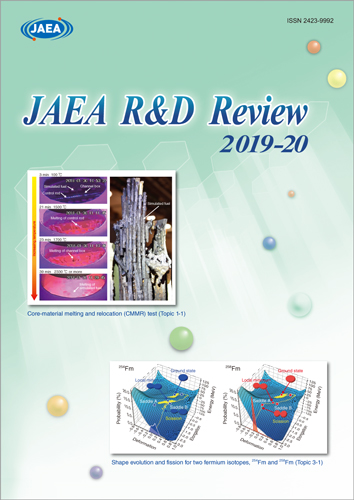The cover was designed with white hexagons similar to the pattern on a tortoise shell, which represents an ancient Japanese symbol of people’s wish for longer lives. Coincidentally, this shape is also that of core fuel assemblies for the prototype fast breeder reactor “MONJU” and the high-temperature engineering test reactor “HTTR”.
The top left figure shows results from the core-material melting and relocation (CMMR) test, and the bottom right figure shows the shape evolution and fission for two fermium isotopes, 254Fm and 258Fm.
The core-material melting and relocation (CMMR) test was conducted to understand the collapse, melting, and relocation of core materials during the TEPCO’s Fukushima Daiichi NPS accident. A fuel assembly simulating the core structure of a boiling water reactor (BWR) were heated by high-temperature plasma (here, ZrO2 pellets were installed, rather than fuel pellets). More details can be found on page 12 in Chapter 1, Topic 1-1.
The fission process for two fermium isotopes, 254Fm and 258Fm, proceeds by tracing the local minima on the potential energy surface. More details can be found on page 37 in Chapter 3, Topic 3-1.

About the activity status of the whole agency including CSR,
please see the anual report "Japan Atomic Energy Agency 2019".
JAEA R&D Review 2019-20
| Published by | |
| Japan Atomic Energy Agency in January 2020 | |
| Editorial Board | |
| Chief editor: Hiroshi Nakashima | |
| Editors: | Kenji Tatematsu, Tomoaki Suzudo, Mitsuo Koizumi, Takaumi Kimura, |
This publication is issued by Japan Atomic Energy Agency (JAEA) on a yearly basis. |
|
|
Address: 2-4 Shirakata, Tokai-mura, Naka-gun, Ibaraki-ken 319-1195, Japan Phone: +81-29-282-6387, Facsimile: +81-29-282-5920, |
|
All Rights Reserved by JAEA (c)2020 |
|